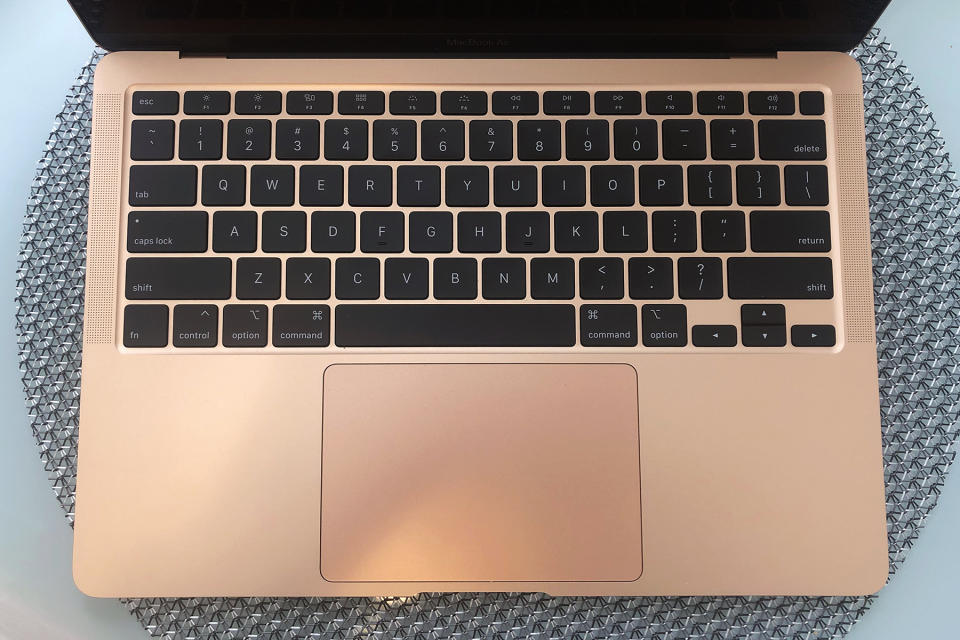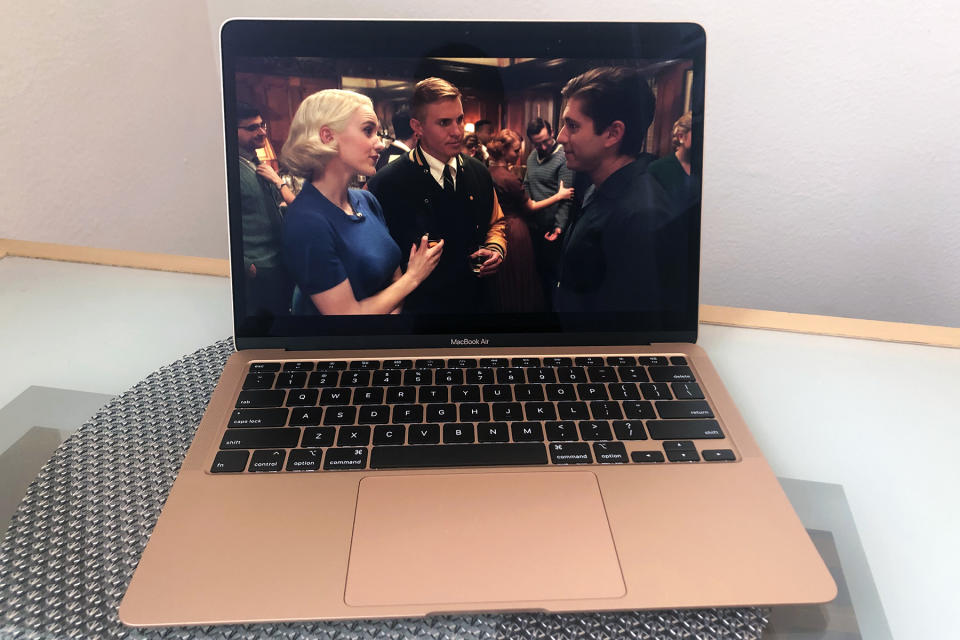Apple MacBook Air review (2020): A return to form
The Air is now easier to recommend, thanks to a price drop, increased storage and vastly improved keyboard.
For the first time in years, Apple has a sub-$1,000 MacBook. Technically, anyway. The new and improved MacBook Air starts at $999, a drop from its old $1,099 base price. Notably, Apple also doubled the entry-level storage from 128GB to 256 gigabytes. Most important of all, though, Apple fixed the keyboard, porting over the same new scissor-style design the company first debuted on last year's 16-inch MacBook Pro.
This marks a return to form for the Air, a machine that, until now, we were hesitant to recommend over the similarly priced entry-level 13-inch MacBook Pro. But with a lower price, more generous specs and a functional, even pleasant, typing experience, the Air might once again be the MacBook for most people.
This is the most important upgrade the new Air has to offer. Typing on this was such a pleasure that I was sad when I had to hand over the machine to our video producer Brian to take beauty shots. During my testing, I also had a work-issued MacBook Pro at my disposal, and I very quickly defaulted to the Air, even though it's less powerful. I pretty much only returned to my Pro when I needed to be on Engadget's VPN, which was not often.

We may as well start with the keyboard. As I said, This is the same underlying design you'll find in the 16-inch Pro, just smaller. Apple says the keyboard was inspired by its existing Magic Keyboard, the standalone one that ships with iMacs. For starters, Apple reverted to a so-called scissor design -- you know, the thing butterfly model was designed to replace. This time, though, there's a new rubber dome under the keycaps and a mechanism that locks at the top of the stroke to minimize wobble.
Typing on the Air is just so much more efficient than on the Pro. With the old butterfly keyboard, I get stuck keys -- the letter e multiple times, periods where I don't need them. Or sometimes my key presses don't register at all. But with the Air, each keystroke feels firm and springy. I can type quickly, aggressively, knowing the keyboard will keep up. I rarely make typos. And when I do it's not the keyboard's fault, it's my own.

As with the 16-inch MacBook Pro, Apple also moved to a so-called inverted-T layout for the arrow keys. Now, the left and right arrows are shorter than the up-and-down arrow stack, making them easier to find by feel if you're, say, editing text or doing work inside a spreadsheet. I dig it, but if I'm honest, I never had much trouble finding the arrow keys by feel with the old layout. Besides, the arrow keys were the least of the keyboard's problems.
Otherwise, the design is familiar: an aluminum chassis with a slightly tapered profile, available in three colors, silver, space gray and rose gold. There's no Touch Bar here; just an old-fashioned Function row with a Touch ID sensor all the way on the right. As ever, the fingerprint reader was easy to configure and consistent in everyday use.
The 13.3-inch display has the same resolution as the last-gen Air -- 2,560 x 1,600 -- with slim bezels and Apple's True Tone technology, which automatically adjusts the color temperature depending on the ambient light. The Air has had True Tone for a little while now, but just in case you're new to it, the difference is mainly noticeable after you've done a side-by-side comparison by toggling True Tone on and off in the system settings. The old color settings are fine in isolation (I'm looking at them now on my work-issued MacBook Pro), but they clearly seem colder and bluer next to a screen with True Tone enabled.
In real-world use, the display served me well during long workdays at home (check out Dark Mode apps in particular for some deep blacks). And in the evenings, I enjoyed streaming shows like The Marvelous Mrs. Maisel (yes, late to the game there), with good viewing angles whether the machine was balanced in my lap or on a coffee table in front of me.

Everything else on the outside is the same too. The same 2.8-pound weight. Same dimensions. Same selection of ports -- which is to say, just a headphone jack and two USB-C Thunderbolt 3 connections. If you want more than that, you'll have to step up to the MacBook Pro, which has four of them. Either way, best to invest in a dongle or two now if you haven't already.
I can't speak for all of you, but I know I still use some peripherals (a Blue Yeti podcasting mic, for example) that would be easier to use if there was a full-sized USB-A port built-in. And, yes, I know every I/O standard goes obsolete eventually -- I'm old enough to remember the disappearance of floppy disk drives and VGA ports -- but if Microsoft can still offer a USB-A socket on the Surface Laptop 3, why have we come to accept Apple leaving it out? Even Dell at least includes an adapter with the XPS 13.
I won't linger on sound quality, but suffice to say, it's decent for what it is. That said, it wouldn't be my first choice for listening to music. So many of us own smart speakers these days. Me? I have a Sonos One in both my kitchen and living room. If you have access to an AirPlay-enabled speaker, whether that's a Sonos or Apple's own HomePod, you're still better off streaming through that. But, in a pinch, the Air's built-in stereo speakers are good enough for casual listening and video calls. (If you're like me, you're doing a lot of those these days.)
On the performance front, Apple upgraded the CPUs on offer to Intel's 10th-generation Core chips and fresh Intel Iris Plus graphics. The entry-level $999 model has a dual-core 1.1GHz Core i3 chip and 8GB of RAM, but the one I tested had a quad-core 1.1GHz Core i5 processor. That model will cost you $1,299. If it were me, I'd spring for the Core i5 model; laptops are meant to last for several years, after all. I imagine most of Engadget's tech-savvy readers would make the same choice.

Coming from my work computer, which has a quad-core Core i7 chip and 16GB of RAM, I didn't notice a significant drop in performance for most tasks. Things like Slack, Spotify, browsing, email, Messages, Notes all work smoothly on the Air; no Core i7 chip needed.
Occasionally, there were small annoyances. Like when I tried to rotate images in Apple's Photos app. There was just a tiny delay, but letdowns like that were the exception, not the rule. If I were going to be doing a lot of work editing photos and videos, I'd probably still go for the Pro. But I make my living as a writer and editor, so the Air would be fine the majority of the time. I'd say the same is probably true for most people.
That said, I can't help but feel like Apple could have been even more generous with specs. In addition to offering a USB-A port on the Surface Laptop 3, Microsoft offers a Core i5 processor for $999, albeit with 128GB of storage, not 256GB. (For the record, that configuration is sold out on Microsoft's site, but I mention it anyway to make a point about what a tech giant can afford to include at a $999 price point.)
In fairness to Apple, it does seem to have bested Dell's offer with the newest XPS 13, whose $999 configuration has a piddly 4GB of RAM and Intel UHD graphics (as opposed to Iris Plus, which is saved for higher-end configurations). Like the Air, the $999 2020 XPS 13 has a Core i3 processor and 256GB of storage, so they're well-matched on those specs, though that 4GB of RAM would make this configuration a non-starter for me.
If you have money to invest in up-sells, both the $999 and $1,299 configuration can be upgraded with a 1.2GHz quad-core Core i7 CPU, 16GB of RAM and either a 1TB or 2TB SSD. The graphics don't get better, so if you think you want a discrete GPU, consider a MacBook Pro instead.

As for battery life, Apple is still claiming 12 hours of video playback or 11 hours of web browsing. I came pretty close to that. I put together a 13-hour playlist in the Apple TV+ app just to be safe, but in fact, the machine went dark after 11 hours and 34 minutes. Close enough, I'd say. It's also worth noting that this falls in line with Microsoft's own claims for the 13.5-inch Surface Laptop 3, which is rated for 11.5 hours of "typical device usage." Neither of these machines come close to the new Dell XPS 13, however, which clocked 15 hours and 55 minutes.
In daily use, your mileage is obviously going to vary. Apple's official 11-hour stat assumes you're browsing in Safari. I use Chrome out of habit, even though I know it's a battery hog. That said, the drain wasn't so bad, at least not until I started doing calls in Hangouts. At one point the battery plunged 13 percent even during a brief meeting. Once I finished the call, the battery continued to drain at a slower rate. All that said, I'd sooner expect a workday of unplugged use -- maybe not the full 11 hours under most circumstances.
If you're shopping for a lightweight laptop and don't plan on using heavy-duty apps or doing serious gaming, the Air is one of a small group of favorites, including the Dell XPS 13 and Surface Laptop 3. The MacBook Air isn't just a solid choice for Apple fans. Thanks to the lower starting price, increased storage and vastly improved keyboard, it's worth considering for most people.

